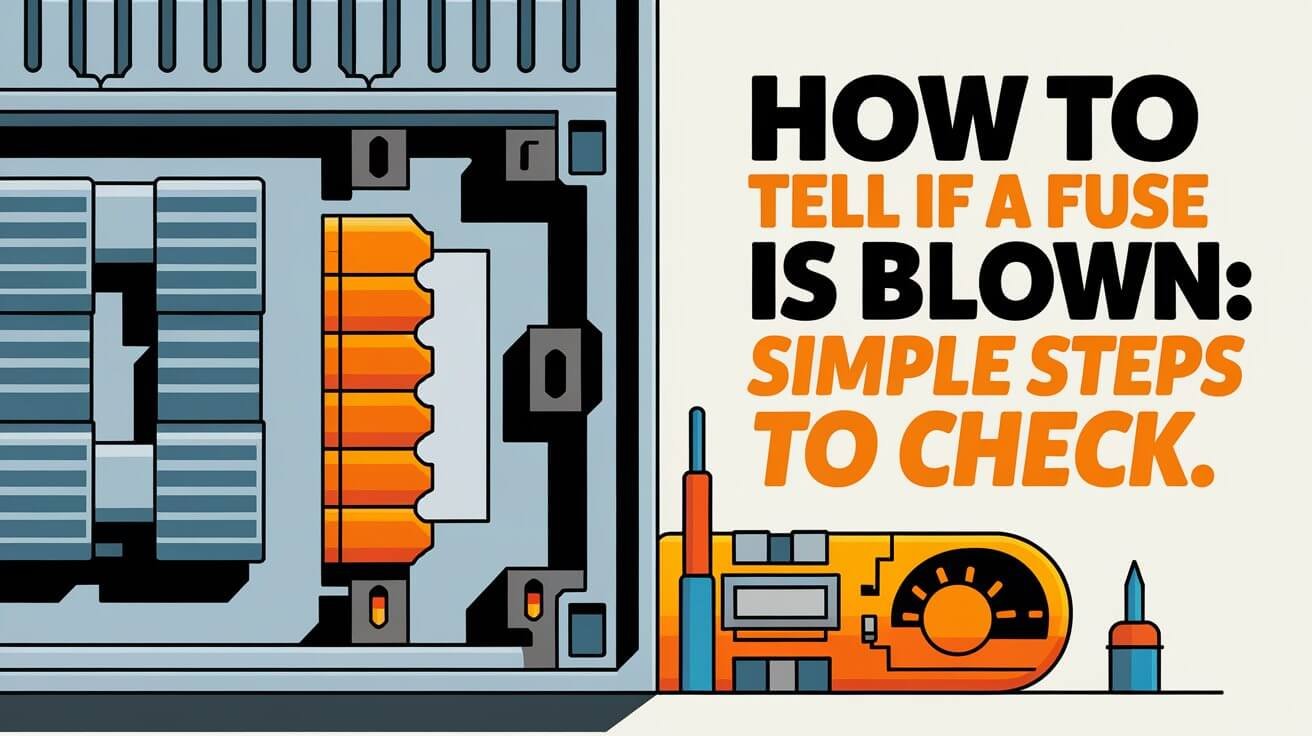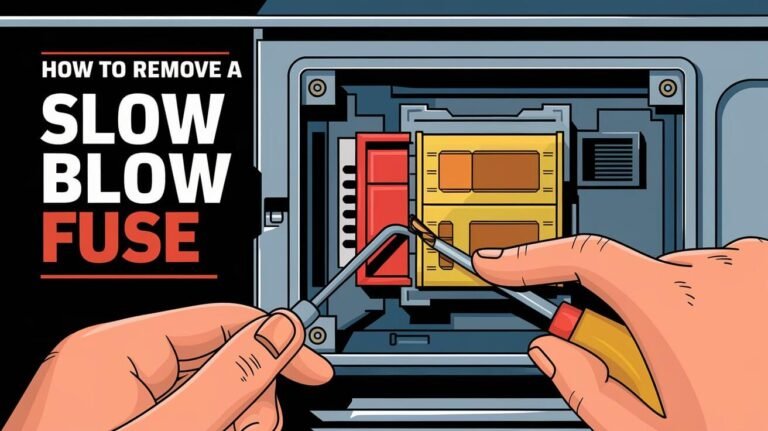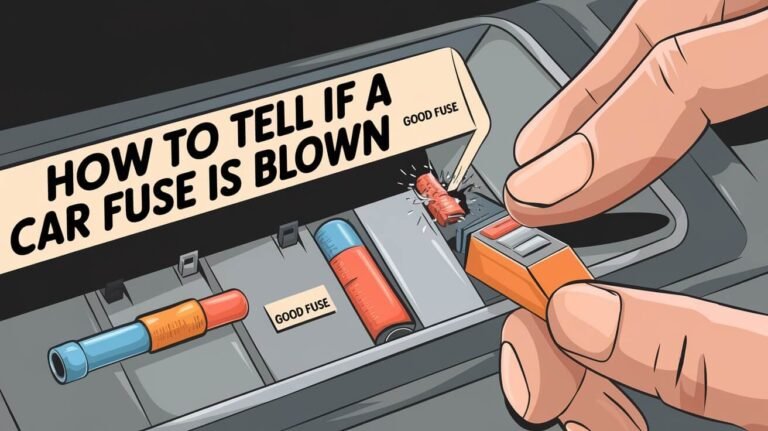
Fuses are key in stopping damage from too much electricity. They help avoid electrical shock. Knowing how to spot a blown fuse is vital for safety. It’s a simple task with the right help.
It’s important to know how to identify a blown fuse. Fuses work well for a long time if used right. But, they can fail due to power surges or short circuits. Spotting a blown fuse helps keep things safe and prevents damage.
Basic Signs of a Blown Fuse
A blown fuse shows up in several ways, like visual signs, power loss, and a burning smell. Look for a gap in the wire or a metallic smear inside the glass tube. This means a fuse has blown. You might also notice a power outage in certain appliances or areas of your home.
When a fuse blows, it can cause a power outage. This can be really frustrating, like when it happens at a bad time. But, it’s important to fix it quickly to avoid more damage. A blown fuse can also make a burning smell, which is dangerous if not handled right.
Visual Indicators
Some signs of a blown fuse include a broken filament or discoloration. It’s a good idea to check your fuse box often to catch problems early.
Power Loss Symptoms
Power loss symptoms can vary. They depend on where and how bad the blown fuse is. Some common signs include:
- Appliances not turning on
- Dim or flickering lights
- Complete power outage in a specific area
Burning Smell Detection
A burning smell can mean a blown fuse. This smell might also point to a bigger problem, like a short circuit. It’s very important to find and fix the smell’s source quickly to avoid a fire.
| Signs of a Blown Fuse | Description |
|---|---|
| Visual Indicators | Broken filament, discoloration, or a gap in the wire |
| Power Loss Symptoms | Appliances not turning on, dim or flickering lights, or complete power outage |
| Electrical Burning Odor | A distinct smell indicating a blown fuse or a more serious issue |
Essential Safety Precautions Before Checking Fuses
When working with electrical systems, electrical safety is key. Always turn off equipment before checking fuses. This step helps avoid electrical shock and keeps you safe.
To keep things safe, find the fuse box and know which fuse to check. Make sure you’ve fully powered down before you start. Handling electrical parts with care is also important, as they can break easily.
Some important safety tips include:
- Turning off the main power supply before checking fuses
- Using insulated tools to handle electrical components
- Avoiding overloads and ensuring proper power disconnection
- Regularly inspecting wiring and connections for damage or wear
Following these steps and focusing on electrical safety, you can lower injury risks. Always be careful with electrical parts and never try to check or replace fuses without the right safety measures.
Tools Required for Fuse Testing
To test a fuse, you’ll need the right tools. An electrical multimeter is key for this task. It can measure AC and DC voltage, electrical resistance, and current flow. This makes it great for finding electrical problems.
A voltage tester is also vital. It checks if a fuse is blown or not by measuring voltage. Always follow safety rules to avoid getting shocked when using it.
Essential Tools for Safe Fuse Testing
- Electrical multimeter
- Voltage tester
- Insulated gloves
- Insulated tools
With these tools and safety steps, you can test fuses well and find electrical issues. Always be careful when working with electricity. If unsure, get professional help.
How To Tell If A Fuse Is Blown Through Visual Inspection
Checking a fuse visually is a simple and effective method. You can spot a blown fuse by looking for a gap in the wire or a metallic smear inside the glass. This is common in glass fuses.
To inspect a fuse correctly, you need to know what to look for. Look for damage like a broken wire or a dark spot. These signs mean the fuse is blown. Here are some important things to check during a visual inspection:
- Check for a visible gap in the wire
- Look for a metallic smear on the inside of the glass
- Inspect for signs of damage, such as a broken wire or a dark spot
Following these steps and using the right techniques, you can easily check a fuse visually. Always keep safety in mind when working with electricity. If you’re not sure about anything, it’s best to get help from a professional.
| Fuse Type | Blown Fuse Appearance | Fuse Inspection Techniques |
|---|---|---|
| Glass Fuses | Visible gap in the wire or metallic smear on the inside of the glass | Visual inspection for signs of damage |
Different Types of Blown Fuses
Understanding the different fuse types is key when dealing with electrical issues. Fuses like cartridge and plug fuses protect circuits from damage. Circuit breakers also prevent electrical overloads.
Fuses can blow for many reasons. Overloading is a big one, like when too many appliances are plugged in at once. Power surges or failures and short circuits also cause fuses to blow. Over time, fuses can wear out and fail, even without any problems with the electrical system.
Cartridge Fuses
Cartridge fuses are very common in electrical systems. They have a glass or ceramic tube filled with a material that melts when too much current flows. They come in various sizes and ratings for different uses.
Plug Fuses
Plug fuses are used in older systems and are screwed into a fuse panel. They are not as common as cartridge fuses but are used in some places. It’s important to use a new fuse with the same amperage rating as the blown one to avoid electrical dangers.
Circuit Breaker Identification
Circuit breakers automatically turn off power when they detect an overload or short circuit. They are used in modern systems and come in different types. Knowing how circuit breakers work is key to fixing electrical problems.
| Fuse Type | Description | Application |
|---|---|---|
| Cartridge Fuse | Glass or ceramic tube filled with a fusible material | Electrical systems, appliances |
| Plug Fuse | Screw-in fuse used in older electrical systems | Older homes, industrial applications |
| Circuit Breaker | Automatically switches off power supply in case of overload or short circuit | Modern electrical systems, residential and commercial applications |
Testing Methods for Confirming Blown Fuses
To find out if a fuse is blown, you can use a few methods. One way is the multimeter test. You set the multimeter to the resistance or Ω (Ohms) setting. Then, you place the leads on each end of the fuse.
A reading between 0 and 5 Ω means the fuse is good. This shows it’s working right.
Another method is the continuity check. You can use a multimeter or a continuity tester for this. It checks if electricity can flow through the fuse without interruption.
If the fuse is blown, the continuity check will show an open circuit. This means there’s no path for electricity.
Some common ways to test fuses include:
- Visual inspection: checking the fuse for signs of damage or wear
- Multimeter test: measuring the resistance of the fuse
- Continuity check: checking for a continuous path for electricity to flow through the fuse
It’s important to be safe when testing fuses. Always turn off the power to the circuit first. Use protective gear too. By using these methods, you can tell if a fuse is blown. Then, you can replace it to keep your electrical system safe and working well.
| Testing Method | Description |
|---|---|
| Multimeter Test | Measures the resistance of the fuse |
| Continuity Check | Checks for a continuous path for electricity to flow through the fuse |
| Visual Inspection | Checks the fuse for signs of damage or wear |
Common Causes of Blown Fuses
Fuses can blow for many reasons, like too much current, short circuits, or appliances using too much power. Knowing why fuses blow helps avoid it happening again. Overloading a circuit is a big reason, showing how important it is to not use more than the circuit can handle.
Short circuits are another big cause, often from bad wiring or the wrong fuse. This can damage your property, making it key to pick the right fuse and check wiring, even in older homes.
Circuit Overload Issues
When too many devices use one circuit, it’s overloaded. To fix this, spread the load or get a circuit that can handle more.
Short Circuit Problems
Short circuits happen from bad wiring, wrong fuse choice, or bad connections. A pro electrician can spot and fix these problems before they cause more trouble.
Faulty Appliances
Appliances that use too much power can also blow fuses. It’s vital to check appliances often and replace them if they’re not working right to avoid overload and short circuits.
Some common reasons for blown fuses include:
- Overloaded circuits
- Short circuits
- Faulty appliances
- Faulty wiring
- Arc faults
- Power surges
| Cause of Blown Fuse | Description |
|---|---|
| Overloaded Circuit | Exceeding the circuit’s capacity |
| Short Circuit | Faulty wiring or incorrect fuse type installation |
| Faulty Appliances | Drawing more current than necessary |
Proper Fuse Replacement Steps
Replacing a fuse requires careful steps for safety and accuracy. First, identify the fuse type you need to replace. There are slow-blow and fast-blow fuses, with different amperage ratings like T2A and F2A. Always use the same type of fuse to avoid risks of electrocution and fires.
Choosing the right fuse is key for your devices to work safely. Common sizes include 5x20mm and 6.3x32mm. Make sure the fuse’s amperage and voltage match your device’s needs. Always follow the manufacturer’s instructions and take safety precautions when installing a fuse.
Here are some tips for fuse replacement: * Always turn off the power before starting. * Use a multimeter to check if the fuse is blown. * Replace it with a fuse of the same type and rating. * Regularly check and maintain your fuse box to avoid future problems.
If the fuse blows again soon after, it might mean a bigger electrical issue. In such cases, it’s wise to call a professional electrician. With the right fuse and proper installation, your devices will work safely and efficiently.
| Fuse Type | Amperage | Voltage |
|---|---|---|
| Slow-blow | T2A, T1A, T0.25A | 250V |
| Fast-blow | F2A, F1A | 250V |
Circuit Protection Solutions
Keeping your home’s electrical system safe and working right is key. You need to stop overloads and short circuits. These can blow fuses or trip circuit breakers.
It’s important to spread out the load on each circuit. This stops fuses from blowing because of too much power. You should balance the load to avoid overloading.
Load balancing keeps your electrical system healthy. By spreading the load, you lower the chance of blown fuses and tripped circuit breakers. Plug your big power users, like refrigerators and air conditioners, on their own circuits.
Load Distribution Tips
- Identify power-hungry appliances and plug them into separate circuits
- Avoid overloading a single circuit with too many devices or appliances
- Consider installing new circuits or upgrading your electrical panel to support increased power demands
Upgrade Considerations
If fuses keep blowing or circuit breakers trip often, it’s time to upgrade. You might need a new electrical panel to handle today’s power needs. This upgrade can protect your circuits better and prevent fires.
The 2022 Inflation Reduction Act also offers rebates for electrical upgrades. This makes it a smart choice for your home.
When to Call an Electrician
At times, it’s wise to call a professional electrician for your safety and electrical system’s health. If you keep getting blown fuses or tripped breakers, it might mean you have complex wiring problems. These need an expert’s touch.
A pro electrician can spot and fix issues before they get worse. For example, rust or corrosion near the breaker box or using lots of extension cords are red flags. Also, if you get electrical shocks, lights flicker, or switch plates are hot, it’s a sign of a bigger problem. A licensed electrician should check it out.
Emergency Situations
In emergencies like a power outage or electrical fire, act fast and call an electrician. They can quickly assess the situation and ensure your safety. They’ll also work to get your power back on.
Complex Electrical Issues
For complex electrical problems, like old systems or faulty wiring, you need a pro. They can handle the tricky parts of your electrical system. This way, you know your system is safe and meets all electrical codes.
Here are some signs you might need a professional electrician:
- Frequently blown fuses or tripped breakers
- Electrical shocks or flickering lights
- Hot switch plates or outlets
- Rust or corrosion around the breaker box
- Heavy reliance on extension cords
Conclusion
As we finish our look at blown fuses, the main point is electrical safety. Knowing how to spot and fix blown fuses helps you keep your home’s electrical system safe. It’s key to check fuses often and make sure they’re not overloaded.
For electrical safety and fuse management, keeping an eye on your home electrical maintenance is vital.
When you face big electrical issues or emergencies, call a pro like The Local Electrician. They have the skills and dedication to ensure your electrical system is safe. People love The Local Electrician for their quick service, smart solutions, and deep knowledge of local power systems.
Frequently Asked Questions
What are the basic signs of a blown fuse?
Signs of a blown fuse include visual clues like discoloration or a broken filament. You might also notice power loss in certain appliances or areas. The smell of burned electrical parts is another clear sign.
What safety precautions should be taken before checking fuses?
Always disconnect the power first. Then, follow safety steps for handling electrical parts.
What tools are required for fuse testing?
You’ll need a multimeter for fuse checks and different voltage testers. Don’t forget safety gear like insulated gloves and goggles.
How can you tell if a fuse is blown through visual inspection?
Look closely at the fuse’s appearance. Check for any signs of damage. Different types of fuses look different when they’re blown.
What are the different types of blown fuses?
There are cartridge fuses, plug fuses, and circuit breakers. Each type has its own look and function.
What methods can confirm if a fuse is blown?
Use a multimeter for tests and continuity checks. These methods are more reliable than just looking at the fuse.
What are the common causes of blown fuses?
Overloaded circuits, short circuits, and faulty appliances often cause blown fuses.
How do you properly replace a blown fuse?
Choose the right fuse type and rating. Always follow safety rules when replacing a fuse.
How can you protect circuits and prevent frequent fuse blowouts?
Use load distribution to avoid overloading circuits. You might also need to upgrade your electrical system.
When should you call an electrician?
Call an electrician for emergencies or complex issues. Certified pros are best for these jobs.



